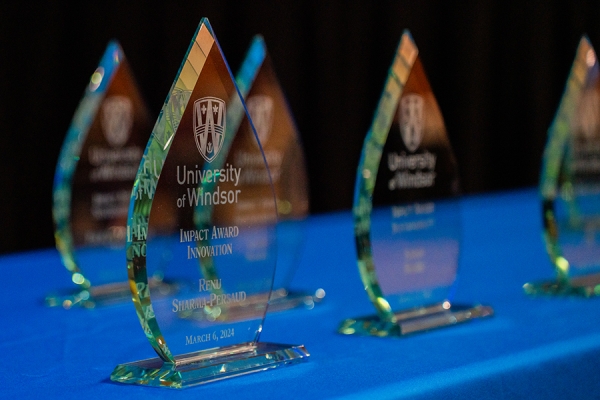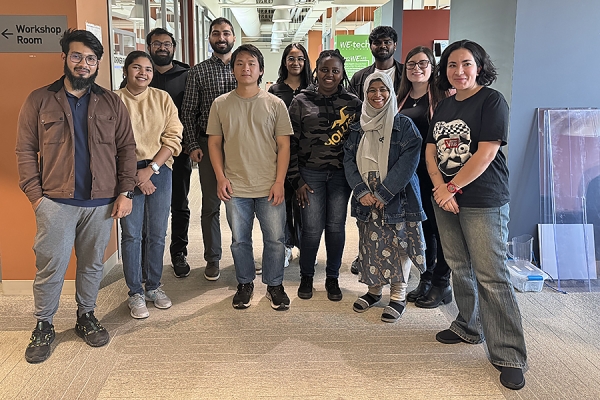 Mikala Jones leads Seth Sugarman through weight training during an Adaptive Physical Exercise session in the Toldo Lancer Centre.
Mikala Jones leads Seth Sugarman through weight training during an Adaptive Physical Exercise session in the Toldo Lancer Centre.
Asked what his favourite part of coming to the gym is, Seth Sugarman replied: “everything.”
Sugarman is a participant in the Adaptive Physical Exercise (APEX) program, a partnership between the University of Windsor and Community Living Essex County that connects student volunteers with individuals with intellectual and developmental disabilities.
“The key piece to our program is that it’s an inclusive exercise program. So, it’s critical that they work out in our gym, alongside our community members and university students, and they’re in those spaces — shoulder to shoulder,” said APEX Research Group founding co-director Chad Sutherland.
Sutherland, who also serves as director of operations at the Centre for Human Performance and Health within the Department of Kinesiology, works alongside professor Sean Horton in crafting the exercise programming.
The 12-week program brings adults supported by Community Living Essex County to the Toldo Lancer Centre twice a week for an hour-and-a-half of exercise with a volunteer personal trainer. Participants engage in exercise routines, including weightlifting, cardio, and playing basketball, ping pong, and other sports.
Sugarman, along with participants Mary Ellen Smith and Kelly Thibert, were all smiles during their sessions, dancing in between sets and cheering each other on as they took turns shooting hoops in the gym.
“I love it,” Thibert said with a smile.
“I’m getting stronger every time I come,” Sugarman noted.
All three, like others who participated in the program, have since made fitness a regular part of their routine by joining local gyms.
“It’s a highlight in their life for sure,” said Shelbey Pillon, planning and technology supports manager at Community Living Essex County. “APEX really inspired them to continue their exercise.”
She said that motivation is crossing into their everyday lives as a result.
“They’re going back to their peers and saying, you know, ‘this would be a healthier choice’ or ‘you should walk 30 minutes a day and exercise three times a week because that’s what I learned,’” Pillon noted.
“They’re also learning a lot more about themselves, figuring out, ‘what am I capable of?’”
She shared the story of a young man who was working a labour-intensive job, and tasks such as bending down and pulling weeds posed initial challenges.
“And I can say with APEX, by the end, his physical fitness had improved. So, of course, this was noticed on the job site as well, which was a huge benefit for him,” Pillon said.
The program was initiated in 2010, when Community Living Essex County, noticing a need among the people they support, reached out to the University of Windsor looking for help implementing an exercise program.
“They noticed just poor overall health, like resting heart rates, blood pressures, weight control, nutritional habits — all these things were lower than their neurotypical peers,” Sutherland explained.
With the help of a grant through the Ontario Healthy Communities Initiative, a partnership was established that would continue for the next 14 years.
“We wanted to remove as many barriers as possible,” Sutherland said. “We ran the first program, and honestly, I thought it would be a one-and-done. It’s going to be a cool little side project. After five or six weeks in and just seeing the response, the participants got so connected to our fitness trainers that they didn’t want to leave. And we knew we had to keep doing it.”
He said since then, about 300 alumni and students have been involved in APEX.

A key aspect of the APEX program is having participants work out alongside members of the campus community, says Anna Beneteau.
Beyond physical exercise: the social and emotional benefits
Kinesiology and health studies master’s students Mikala Jones and Anna Beneteau work as program coordinators and say they’ve seen first-hand the transformation participants experience.
“A couple of them weren’t super excited about the exercise component when they first came in — their parent or support worker put them up to it. But over time, you’d see them come and be more engaged,” Jones said. “I thought that was huge because I could see them evolve from someone super shy to someone that constantly wanted to have a conversation with you.”
The additional benefits soon became apparent.
“I think initially when the program started, the focus was on the physiological component: you’re getting exercise, you’re getting your body moving, and it’s good for your health. But as time went on, we realized that there was a social component to it as well,” Beneteau said.
One of the key aspects of that is the truly inclusive nature of the program.
“They learn how to interact with community members that don’t have an intellectual disability from going to these programs. And it builds that comfort level within the general community,” Pillon said.
She explained that comfort is now displayed in their everyday lives, something she referred to as an “unintended outcome.”
“The impact has been significant, extending to areas that are difficult to measure. Like how to communicate with a co-worker when meeting them for the first time,” Pillon explained. “Comparing that with experiences in APEX, where individuals develop a comfort level, for instance, maybe a young man is talking with a female personal trainer. Now, that comfort translates to improved communication with female co-workers in his new job.”
In addition to providing inclusive, barrier-free access to exercise, a key part of the program is conducting research aimed at contributing to adapted physical exercise, disability in sports, sport’s role in social change, and informing policies and practices for developmental services.
Sutherland said the focus of their research will vary based on grants received and interest, exploring areas such as how the program impacts cardiovascular health, motor skills, strength and flexibility gains, along with aspects related to employment.
“Employment and volunteerism are huge. It’s getting individuals with intellectual and developmental disabilities out into the community, taking on meaningful volunteer positions, and feeling like a part of their community. We looked into employment as well and if they do a physical activity program alongside their employment training, will they be more successful?” Sutherland explained.
According to Special Olympics Canada, research shows those registered in Special Olympics programs are five times more likely to work than those who are not.
Sutherland said the program gives participants more self-efficacy and allows them to take on tasks with more confidence.
“We’ve interviewed parents and support workers as part of this research, and they’ll tell us now when asked ‘what do you want to do?’ they don’t choose to watch a movie; they want to play basketball and be more physical rather than sedentary,” he said.
Watch a video on the program here:
Spreading the APEX model worldwide
Both Jones and Beneteau have focused their research on impact the APEX program has on its volunteers.
“Unfortunately, there are biases and stereotypes toward people with IDD, or disability in general, and while students do take classes on special populations that give you a textbook understanding, getting that one-on-one experience allows you to build your own understanding and take that into your career or society in general,” Beneteau said.
Jones’s research dove into what preconceived notions or misconceptions volunteers held about individuals with IDD and how they’ve changed since becoming involved with the program.
“I think that a lot of positive responses came about from my research,” Jones said. “The perception changes for one, but they were also able to build comfort, competence, and confidence with individuals with IDD. A lot have also expressed interest in continuing this type of work.”
This is where Beneteau’s research focus comes in. She looks at alumni who worked with APEX as students and how the experience impacts their vocational paths.
“I look at career decisions, whether that be going into occupational therapy or something within the disability sector, but also how it’s impacted them more broadly,” she said.
Some alumni have gone on to work in the sector, while others have started businesses where they’re now hiring people supported by Community Living because of their experience with APEX.
“This program definitely benefits those supported by Community Living Essex County, but I think there’s an equal benefit to what’s happening for our students who are just in the facility with them and our volunteers who work in the program,” Sutherland said.
The program’s reach now extends far beyond the borders of Windsor-Essex. APEX has since developed an exercise manual for individuals with IDD, which has been downloaded in every Canadian province and 50 countries around the globe, Sutherland said.
“A lot of the families and support workers we talk to say they would love to take them to the gym, but they just don’t know what to do once there. So hopefully this manual is breaking down barriers, and in areas we’re not directly impacting, at least it’s having that effect and getting people moving,” he said.
The manual provides comprehensive exercise guidelines, including a variety of movements and detailed explanations so they can be performed safely. It covers effective warm-up routines, cardiovascular exercises, and strength-building exercises, complemented by graphical illustrations. In addition, users can access demonstration videos on YouTube to visually follow along with the exercises.
“The workbook is phenomenal,” Pillon said. “They’re showing you every step of the way, so that when you do go to a gym or a different recreational program, you know how to kind of start things off. You know proper footwear needed, to bring a water bottle, all those things that help to build that confidence long after the program has finished.”
To learn more about the APEX Research Group and the work its members are doing, visit www.uwindsor.ca/kinesiology/APEX.
Stay up to date with the latest and greatest at UWindsor:









